Before my life at MobileSyrup, I worked in the film industry for several years as a writer and Assistant Director. Depending on the size of the production, there could be anywhere from five to thirty crew members on set at any given time. No matter how small the crew was, though, there was one role that was mandatory: a dedicated audio person.
You can have the best-looking visuals in the world, but if your audio quality isn’t up to snuff, the entire piece just falls apart. It’s the aspect of a movie, TV show, podcast, or YouTube video that separates the high-quality productions from the low budget ones immediately.
Now that I’ve transitioned away from the film industry to the faster-paced world of video production, everything is different. Teams of one or two people are responsible for everything, including audio. And that often results in subpar results. Honestly, audio is tough, and until recently, the setups were clunky and difficult to use.
Enter the DJI Mic 2.
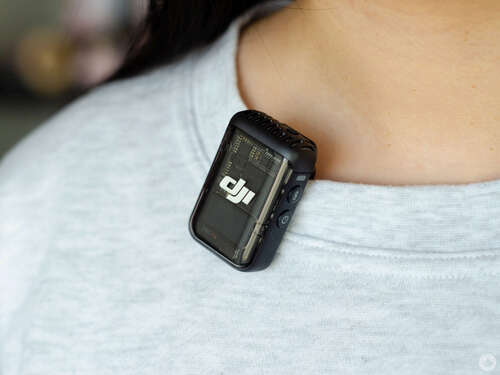
This wireless mic system has entirely changed my workflow for recording videos. It’s removed many of the barriers I faced with audio setups, and while it’s not perfect, it’s one of the easiest recommendations I can make for content creators.
Everything you need in a single case
For those familiar with the first iteration of the DJI Mic, you’ll know it’s an entire audio system that fits in the palm of hand. Its compact design is one of the biggest selling features. Having used the system for nearly two months now, the charging case is an essential part of why it’s so useful. It not only extends the already impressive five-hour battery of the transmitters and receiver by ten hours, but it also keeps them safe in a sturdy case that uses magnets to snap everything satisfyingly into place.
The case fits two transmitters, a receiver, and two smartphone adapters. And that’s everything you need to get up and running. Each transmitter comes with a windscreen attachment — also known as a “dead cat” to my audio friends out there — that slots into the top, along with a magnet for attaching the unit to clothing and surfaces. To sync the transmitter to the receiver, simply place them in the charging case and you’re good to go.
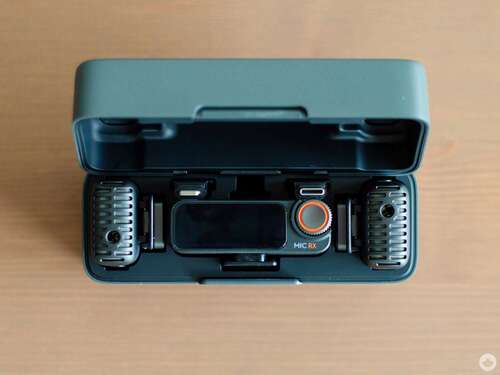
Unlike with other systems, you won’t need XLR cables, antennas, monitors, or endless batteries. For me, audio has always been the most annoying aspect of video production. Wireless mic packs are bulky, burn through batteries, have interference issues, and just generally cause a hassle. Until now, I always brought a Zoom recorder as an emergency backup — and that’s bigger than the entire DJI Mic 2 family. Now, I don’t need to worry about any of that.
With a single cable, you can record from the receiver to a camera or an external device. And if you just need to record audio without any setup at all, you can record directly to the transmitters. It’s as simple as hitting record on the side of the device and you can save hours of high-quality audio that can be transferred directly to your computer with a USB-C cable. I no longer need to worry about connection noise, the audio is clean and safely stored onboard the device itself.
It’s hard to describe how mind-blowing the quality is for the price, size, and speed of the setup. No, it’s not going to replace a shotgun mic on a boom arm, but it’s easy to see why these have quickly become the go-to option for content creators everywhere.
Great sound with a cumbersome UX experience
It’s safe to say that I love the simplicity of the system and how quickly it gets you back to filming instead of worrying about cables, but how is it to actually use? It’s brilliant — with a few caveats.
The DJI transmitters produce clear audio that does a great job of isolating voices, especially in outdoor environments. Its low-cut setting and windscreen delivered a remarkably clean voice recording on a windy Toronto street. You have the option of recording in stereo, mono, or safety mono — we’ll get to that last one in a bit — and there are plenty of additional quality-of-life options as well. The auto-off feature has been a lifesaver on long shoots with breaks between shots. But not everything works exactly as intended.
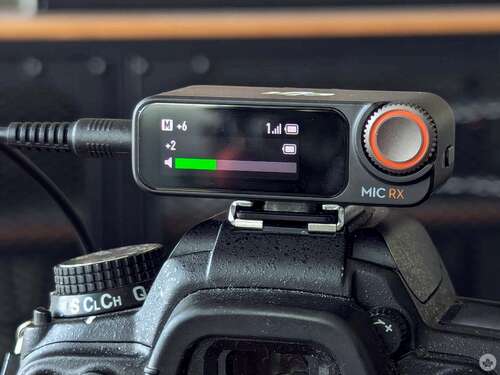
The DJI system has a built-in auto setting that measures the audio input and adjusts the levels accordingly. For the most part, this worked well when I used it. When recording with my coworker, the audio level peaked around -10dB. Nearly perfect. But when I recorded my own voice, which has a slightly deeper register, it needed manual adjustment to keep it from peaking.
The great news is that the system offers a safety track for those instances. By changing the recording track to the safety mono setting, the device will record a second track that’s 6dB lower. It provides that little bit of peace of mind when you don’t know exactly where someone will land.
The bigger issue comes from operating the menus on the DJI receiver. Almost everything is done through the touchscreen on the receiver, and the touchscreen is tiny. I mean, really tiny. Almost all of the menus require swiping motions that don’t always register. This issue is exacerbated when you’re outdoors, taking gloves on and off. Most of the quick level changes are made using the wheel next to the screen, thankfully, but when you need to make an adjustment through the menus, and it’s not registering your inputs, and you’re holding up a shot, and… it’s frustrating.
Mic placement is key
It’s a testament to how incredible these devices are that my only other complaint is a fairly minor one about the weight of the transmitters. But it’s still worth mentioning because it can affect the overall performance.
Traditionally, lavalier mics (lavs) use a long cable to extend from the heavy mic pack up to a small omnidirectional microphone that’s lightweight and easy to hide. It can be clipped or taped to the inside of someone’s clothing with ease. The DJI Mic 2 transmitter doesn’t require a wire at all, but that requires an increase in size. Hiding the mic isn’t a problem anymore — we’ve all become accustomed to seeing hosts wear mics on their clothing. The issue comes from the weight of the transmitter and its pickup pattern.
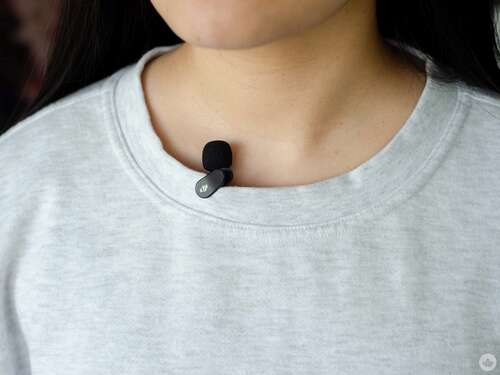
Given that the transmitter is housing a lot of impressive tech beyond just the microphone, it weighs a bit. And your clothing will sag accordingly. Whenever I was either clipping it or magnetically attaching it to someone’s clothing, there was a natural tendency for it to pull forward towards the ground. That change in angle is enough to cause the voice to not be picked up as clearly. I had to be very careful when placing it to make sure it was pointed directly up at the person’s chin or there would be a noticeable loss in quality.
Of course, this can all be solved by holding the mic directly in front of your mouth or by attaching a lav mic. I used both DJI’s own lav and a Sennheiser lav, and both produced great results that were clean and delivered a pleasant fullness. That’s not to say that you can’t get a great sound with the transmitter, you’ll just need to be careful when placing them.
The workflow I’ve always wanted
It’s hard to describe how much the DJI Mic 2 has changed how I work. If I’m doing ADR pickups at home, I no longer hook up a mic to my PC through an XLR cable to an audio interface just for a couple lines. I just quickly take out my DJI mic wherever I am and hit record.
If I need a quick sound bite from someone and I’m not able to set up my camera or audio input, I quickly plug the receiver into my smartphone. It should be noted that it doesn’t appear to be able to record stereo when recording to your phone, but given that this is usually a last resort, this shouldn’t be a problem. It’s amazing that it’s an option at all.
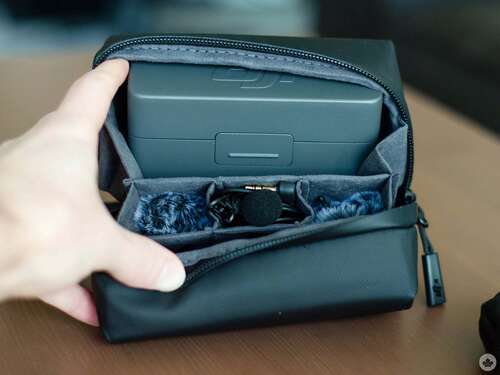
DJI has created a system that keeps you focused on what matters. The DJI bag that holds the case is smaller than a makeup bag and houses everything you need, including multiple windscreens, a lav, 3.5mm cables, and more. Everything is automatically synced and ready to record in seconds. And best of all, it has lifted my audio anxieties. I no longer stress about the audio having hiccups due to signal interference or running out of battery halfway through a shot. You don’t even need an SD card. The DJI Mic 2 understands what content creators need for small productions—efficiency.
It’s an investment, but for the price, I can’t think of a better way to get solid audio. The entire system feels premium in the hand, with a weight and sheen to it that I’d expect more expensive products. The transmitters are especially beautiful, with a transparent front that shows the internal chipset. It was love at first sight.
DJI has long been a favourite of the MobileSyrup crew, and now I can see why. If they keep producing products like the DJI Mic 2, I’d be very surprised if they weren’t a major player up there with Sony in a few years.
The DJI Mic 2 can be purchased at Amazon, Best Buy Canada, and the DJI Store for $479.
MobileSyrup utilizes affiliate partnerships. These partnerships do not influence our editorial content, though we may earn a commission on purchases made via these links, helping fund the journalism provided free on our website.

